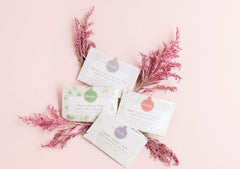Say goodbye to the reign of disposable period products: Menstrual cups are quickly gaining popularity as a safe, reliable, and eco-friendly option for managing that time of the month.
Have you ever thought about using a menstrual cup? It may seem intimidating to make the switch to reusable period products, but it doesn't have to be. Here is a handy guide on how to use a menstrual cup.
What is a Reusable Menstrual Cup?
A menstrual cup is a device that you insert into your vagina. Once inside your vagina, the cup expands and fits snugly in your vaginal canal. It then collects the blood and tissue that usually goes into your pad or tampon.
These devices are made of silicone, and they are also very flexible. When you purchase a menstrual cup, it can last for years with proper care and maintenance.
Menstrual cups are also good for the environment and cost-effective. You can save hundreds of dollars annually and avoid polluting landfills with disposable pads and tampons.
Preparing To Insert A Menstrual Cup
Once you buy a menstrual cup, you have to use it for the first time. The prospect of insertion may seem daunting, but these tips will help you to navigate it easier.
Before you attempt to insert a menstrual cup —
1. Be sure to wash your hands thoroughly.
2. Disinfect the cup! Disinfecting your menstrual cup is so important, but you don’t want to melt the silicone, and if you boil it in a pot, that may happen. Use a cup or mug that you can repeatedly use to clean it, pour boiling water over it, and let it sit for 5 minutes.
Pro tip: Add a few drops of tea tree oil to help the cup — and you! — stay scent-free.
3. Rinse the cup with warm water, let it cool, and you’re ready to go. Once your menstrual cup is in, you should not feel it. Any pain or discomfort means you may need to adjust the cup's position or go down a size.
As a note, you don’t have to disinfect the cup everyday while using it; but, it is a good idea to rinse it out every 12 hours or so and use a mild soap (oil-free and scent-free) once a day.
Pro tip: Pay attention to the little holes on the sides, so that the cup continues to provide adequate suction to the sides of the vaginal walls, ensuring you don’t experience leaks.
Can Inserting a Menstrual Cup Be Painful
If you follow these recommended guides and have the proper size for your body, you shouldn’t feel any pain.
If you have an exceptionally high or low cervix, you may need to get to know where it’s located to ensure you’re placing the cup at the right angle, or you may want to trim the stem (not of Easy-Empty™️) for a more comfortable fit.
Menstrual Cup Folds
There are a few menstrual cup folds that you can try out! Depending on your physical makeup, you may find one works better than another. We’ll get to those in a minute.
While figuring out how to insert a menstrual cup takes practice, you can experience a better period with this amazing period care product. With every fold, don’t be shy. Hold it firmly and work with authority. You’re going to show this thing who’s boss and feel completely in charge of your body by the end of the experience!
U or C Fold
Create a U or C shape by pinching the cup together, and folding it half with the other hand.
Punch Down or Tulip Fold
Holding in one hand, use your pointer finger of the other hand to push down on the rim, as far as you can. The side will fold in, creating a tulip-shaped fold with a narrow tip. Tighten the roll as much as you’d like and grasp firmly.
7 Fold
Hold the cup with both hands, and squeeze to push the sides together. Fold the right corner down, toward the stem, creating a tight 7 fold for menstrual cup. This fold easily opens once inserted.
Triangle Fold
Hold the cup with both hands, and squeeze to push the sides together. Fold the right corner down to the bottom of the opposite side.
Labia Fold
Hold the cup in one hand, and use the thumb and index finger of the other hand to pinch a corner of the cup. Push the corner toward the middle of the opposite rim while wrapping it with the other sides, squeezing to hold in place. This creates a smaller insertion tip similar to the tulip fold.
Origami Fold
Hold the cup at the base; with the other hand, use your index finger to push a part of the rim down half way into the base. With the hand that’s holding the base, tuck the right corner of the cup down toward the base of the opposite side.
How Do I Take My Menstrual Cup Out?
Get in a comfortable sitting position, and bear down with your back muscles. Grasp the base of the cup and push into it with your pointer finger to break the seal. Slowly rock it back and forth until your feel the rim come out.
At this point, you can empty the cup, rinse, and reinsert. You may want to do this in the shower or have some wipes or a peri-bottle nearby to help you cleanse the cup.
You can wear your menstrual cup for up to 12 hours in most cases. However, this depends on the best menstrual cup for your needs.
The removal process needs to have similar hygiene as the insertion. Wash your hands before doing anything, and keep everything as clean as possible.
Learn How to Use a Menstrual Cup
Learning how to use a menstrual cup doesn't have to be a frustrating process. You'll be a pro in no time by following the steps in this guide.
Our website has everything you need about safe, toxin-free period products. Explore our products today for more details.







